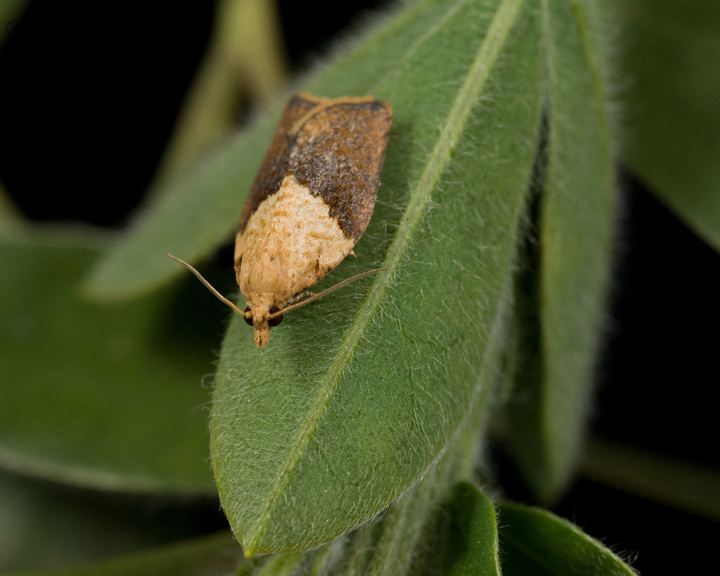We would like to thank Greg Rosenthal of the USDA Animal and Plant Health Inspection Service for this guest post. While we all love moths here at National Moth Week, lets remember that some can be down right destructive to our local environment. So lets keep an eye our for these species when we are at the sheet.
Invasive Moths: A Threat to Biodiversity and Agriculture
National Moth Week is a wonderful time to turn on the porch light—or attend a National Moth Night event—and celebrate biodiversity. But let’s not forget there are some moths that should not be celebrated—namely, the European grapevine moth, European gypsy moth, false codling moth and light brown apple moth. These invasive moths are destructive pests that threaten America’s crops, forests and community landscapes.
Invasive pests of all kinds can be extremely damaging to our natural ecosystems and farmlands. If left unchecked, these hungry pests can grow and spread rapidly, pushing out our native species, placing other species at increased risk of extinction, reducing biological diversity, killing forest trees and altering wildfire intensity and frequency. On our farms, they can destroy crops, close foreign markets to U.S. products from infested areas and cost millions of dollars in controls to industry and government.
Consider these invasive moths:
European Grapevine Moth
First detected in California in 2009, this pest feeds on the flower or fruit of host plants, most often the grape. This small moth might not seem like such a threat until you begin to consider a fine meal without your favorite domestic wine or a summer afternoon picnic without cool grapes to snack on.

European Gypsy Moth
This moth arrived in Massachusetts in 1869 and has a voracious appetite for more than 300 species of shrubs and trees. Since its introduction, it has made its way throughout much of New England, the Atlantic states and the Midwest. The caterpillars defoliate shrubs and trees, leaving them vulnerable to diseases and other pests and eventually killing them after repeated defoliations.

False Codling Moth
This moth feeds on more than 100 host plants, fruit trees, field crops and other plants including apricot, avocado, banana, cacao, cherry, citrus, coffee, cotton, corn, eggplant, grapefruit, grape, hibiscus, lemon, lima bean, lime, macadamia nut, mango, oak, okra, olive, peach, pepper, persimmon, plum, pomegranate, prune, tea, tomato, walnut … (shall we go on?). We found a single male moth in 2008 but—thankfully—none since.

Light Brown Apple Moth
A native of Australia, this moth was first detected in California in 2006. This hungry insect can feed on more than 2,000 species of plants, many of which might be in your own backyard! The light brown apple moth has an adventurous palate, continually expanding its appetite to new plants and crops.

What can you do to help stop this threat and leave hungry pests behind? We’re glad you asked!
- Learn to identify these moths and other invasive pests at HungryPests.com. If you see signs of an invasive pest or disease, write down or take a picture of what you see and then report it at HungryPests.com.
- Do not bring or mail fresh fruits, vegetables, plants, cuttings or soil into your state or another state unless agricultural inspectors have cleared them first.
- Never remove fresh produce, plants cuttings or waste products from your property if your area is under quarantine for one of these moths or other invasive pests, and cooperate with all quarantine restrictions or rules that might be imposed.
- Allow federal, state, or local officials, or contracted workers, access to your property to install and inspect insect-monitoring traps, conduct surveys, carry out control activities or perform other pest management activities.
- Know the quarantines and requirements in your area, especially if you’re planning to move or relocate. You can learn more about moving from a gypsy moth-infested area at YourMoveGypsyMothFree.com.
Enjoy National Moth Week. Celebrate biodiversity.
And please, Leave Hungry Pests Behind!
Moth pest are ever unwanted in households and commercial premises. These moths will infest readily and if not controlled in enough time, will continue to wreck havoc reaching high level infestation which may be complex to eliminate completely.
The humble moth, the weird uncle of the Butterfly family. We have all encountered them, usually when you least expect it, flying straight at your face after opening a wardrobe or noisily flapping around a light casting disturbing shadows across the ceiling.
Not only do they frustrate us with their endless headbutting of light fixtures but they also have the cheek to eat our clothes, carpets and dry foods while simultaneously spreading moth dust everywhere.
Due to the small size of the eggs and larvae most infestations initially go unnoticed. It is only when adults appear or when holes start appearing in your clothing that it becomes obvious. Moths are equal opportunity destroyers of clothing with no preference over wardrobes, closet or drawers so when looking for signs of their presence be sure to check everywhere clothes are stored in your home.